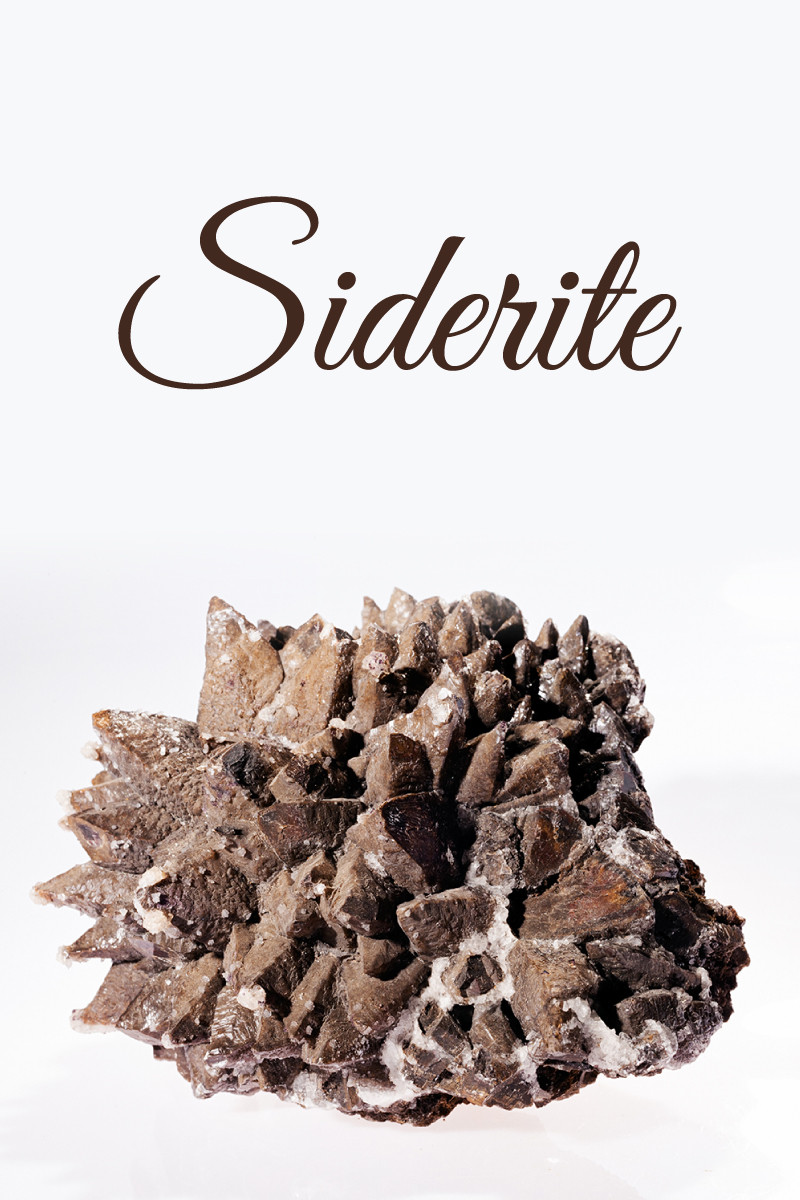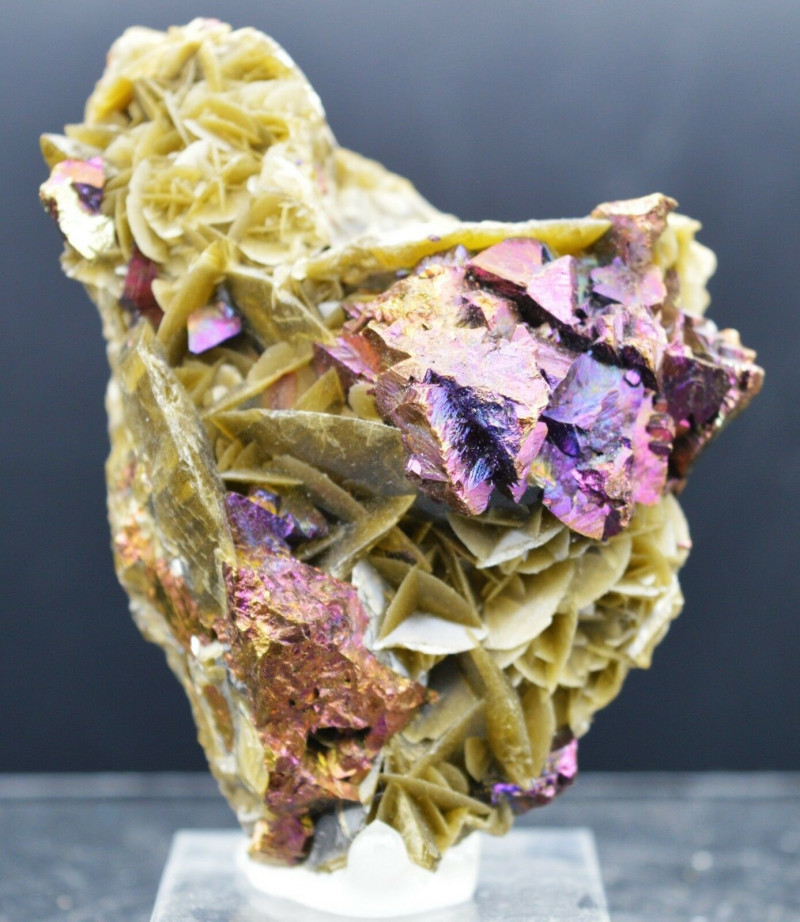
Siderite Gemstone: Properties, Meanings, Value & More
 Siderite (pronounced SYE-der-ite) is a tan gemstone popular with collectors for its interesting crystal shape and rare faceted options.
Siderite (pronounced SYE-der-ite) is a tan gemstone popular with collectors for its interesting crystal shape and rare faceted options.
Though faceted options are popular display pieces, the low hardness and perfect siderite cleavage makes cutting it tricky, so jewelry is less common. Their sweet honey color brings warmth to any room!
But what is siderite crystal and what makes it valuable? Come along as we cover everything you need to know about siderite gemstone healing traits, history, properties, prices, and more!

About Siderite Stone
Siderite is a semi-precious gemstone and iron carbonate mineral. Astrologically, siderite is a zodiac stone for Aquarius.
What is the other name for siderite? This stone may also go by “chalybite,” especially siderite from Cornwall, England. Plus, “siderite” is a type of iron meteorite unrelated to this mineral.
The industrial siderite uses are more widespread than its gemstone uses. So, what is siderite used for?
The primary use for siderite is as a source of iron, though it’s only around 50 percent iron. Luckily, it doesn’t contain phosphorus or sulfur, which makes sourcing iron easier.
Additionally, siderite minerals may also be used for creating brown paint pigment and for creating steel (an iron and carbon alloy). Scientists have manufactured synthetic siderite for removing arsenic and fluoride from water, studying agriculture management, and creating lithium ion batteries.
Siderite Specifications & Characteristics
Siderite is an iron carbonate in the calcite group of similar carbonate minerals. The siderite formula is FeCO3. It forms a series with rhodochrosite, with siderite on the iron-dominant end and rhodochrosite on the manganese-dominant end.
Zinc-dominant smithsonite and magnesium-dominant magnesite are also in individual series with siderite. That said, siderite often has impurities of manganese, iron, and magnesium.
The unique crystal shape that collectors seek out in siderite is its rhombohedral form with curved faces. The mineral can also occur as granular, oolitic, or globular masses. Well-formed siderite crystals are rare.
One aspect that’s helpful in identifying siderite is its magnetism. For one, it’s paramagnetic, so it becomes magnetic when heated. Secondly, siderite is antiferromagnetic, meaning atoms next to each other point opposite ways at low temperatures.
Additionally, siderite has a strong birefringence of 0.24 but lacks pleochroism.
The remaining siderite mineral properties are:
Mohs hardness: 3.5-4.5
Color: Shades of brown, reddish-brown, yellow, black, greenish-brown
Crystal structure: Hexagonal (Trigonal)
Luster: Vitreous, silky, pearly, or dull
Transparency: Transparent to opaque
Refractive index: 1.63-1.87
Density: 3.83-3.96
Cleavage: Perfect, rhombohedral, 1-direction on [1011]
Fracture: Conchoidal to uneven
Streak: White
Luminescence: None
Types of Siderite
Some types of siderite are only unique in their crystal habit while others are unique in their impurities. Below, we’ll break down each siderite variety.
Pelosiderite (Clay Ironstone): Any sedimentary or concretion siderite type, usually with clay minerals mixed in.
Oligonite (Oligon Spar): Manganese-rich variety, though still iron-dominant
Magniosiderite (Sideroplesite): Magnesium-rich variety, though still iron-dominant
Sphaerosiderite: Variety with radiating crystals forming spherical masses inside
Wood Iron: Fibrous variety
It’s important to note that “wood iron” is also the name of a fibrous goethite variety.

Siderite Meaning & History
The siderite crystal symbolizes positivity, ingenuity, and passion. It’s largely associated with relaxation, and spiritual practitioners often recommend meditating with siderite to aid in falling asleep more easily.
The name “siderite” derives from the Greek sideros, meaning “iron,” after the stone’s composition. Austrian mineralogist Wilhelm Karl von Haidinger named siderite in 1845.
Similarly, the other name for siderite “chalybite” comes from the Greek term khálups, meaning “steel,” after its composition of carbon and iron.
Though Haidinger was the first to describe siderite in 1845, the mineral has been used and known throughout the world since ancient times.
In that vein, siderite is one of the minerals collected by researchers at the Switzerland research university ETH Zurich to determine what Earth’s climate was like during the Paleocene and Eocene eras.
Siderite’s use as an iron ore started around the 1800s, particularly following the techniques and machines created by Sir Thomas Buckler Lethbridge and steelmaker Charles Sanderson in 1838.
Switching gears, what is siderite crystal as a healing stone?
Siderite Healing Properties
The coloring and energies of gemstones influence their power as healing stones. Most siderites are brown, so they carry the grounding and stabilizing properties inherent to brown gemstones.
What about siderite’s uses for emotional, physical, and chakra healing?
Physical Healing
Purported physical benefits of siderite include helping with:
Anemia
Absorbing nutrients
Weak, broken, or atrophied bones
Emotional Healing
Emotionally, siderite is purported to bring positivity, facilitate creative problem-solving, and encourage enthusiasm. Crystal healers highly recommend this crystal in the workspace or during job searches.
Chakra Healing
Chakra healing is an ancient practice of bringing energy points (chakras) back into balance when they’re blocked, as the blockage causes negative symptoms. Siderite is a chakra stone for balancing the root chakra and solar plexus chakra.
The root chakra governs fundamental needs of stability and connection. When it’s blocked, you may feel insecure and detached.
The solar plexus chakra governs your self-esteem and confidence, so blockages result in feelings of self-doubt.
Siderite opens both chakras, bringing in feelings of boosted confidence, connection with others, and security.

Siderite Gemstone Properties
Siderite’s value as a gemstone is determined by where each individual stone falls on the categories of color, cut, clarity, and carat weight.
Color
Siderite’s color goes from yellow to black, though it’s usually in between in pale shades of brown. The brownish hues likely come from its iron content. Black hues are caused by manganese impurities, and these varieties are called manganosiderite.
Cut
Besides its low ranking on the Mohs mineral hardness scale, siderite’s perfect cleavage also makes it difficult to facet. Plus, gem-quality crystals are rare, making faceted pieces even harder to come by.
That said, any faceted siderite gems can show attractive colors and some sparkle. Material that forms as masses may become cabochons.
Clarity
Clarity represents the amount of visible inclusions in a gemstone. Some common inclusions in siderite are jamesonite and fluid inclusions. More often, siderite is an inclusion in other stones like quartz.
Visible inclusions only lower the value of transparent siderite. Inclusions and facet edges may appear doubled in faceted stones because of siderite’s strong birefringence.
Carat Weight
Though rough siderite may be large, faceted specimens are almost always 1-5 carats. Any faceted stone above 1-2 carats is significantly more valuable.

Siderite Formation & Sources
Siderite forms in oxygen-deficient environments when ferrous iron reacts with carbonate ions. The mineral is a sedimentary precipitate, meaning it forms when the minerals in water precipitate.
This mineral can also form inside metamorphic rocks. Most often, you’ll find siderite in sedimentary deposits, hydrothermal veins, and banded iron beds.
Mining Locations
Where is siderite found? Some of the best siderite comes from Portugal and Brazil.
Additional sources for gem-quality siderite are:
Austria
Bolivia
Canada
Greenland
England
France
Germany
Italy
Namibia
South Africa
Switzerland
USA (Arizona, Colorado, Connecticut, Idaho, North Carolina)
Now, how much does siderite cost?

Siderite Price & Value
The most expensive siderites are faceted gems, as these are rare. Average prices for faceted siderite are $40-$55 per carat. A less expensive faceted option is quartz containing siderite, which fetches $15-$20 per carat.
Rough siderite specimens at wholesale are always under $1 per carat, usually around $0.10-$0.20 per carat.
Lastly, let’s discuss proper gemstone care.
Siderite Care and Maintenance
Siderite jewelry isn’t common because it’s so fragile, but if you do find jewelry options, you must handle them with delicacy to ensure they don’t become scratched or broken. Safer jewelry options are pendants, brooches, and earrings.
You can clean siderite with the standard soft toothbrush dipped into a mixture of warm water and mild soap. Rinse the stone well, then dry it with a dust-free microfiber cloth. Avoid using steam or ultrasonic cleaners.
Store your siderite stone away from other gems to avoid scratches.
Siderite: A Signature Stone for Any Collection!
Though its value is mostly in its industrial uses, siderite gemstones are a rare and beautiful addition to any mineral or gem collection. Their earthy hues are perfect for creating a deeper connection to nature and filling your space with grounding energies!
Search the Gemstone Encyclopedia
Related Auctions
Related Articles
Originally the Birthstones or gemstones were associated with a zodiac sign or the month of a individuals birth. Find out what your stone is and view the stones we have for sale
8th Feb 2021
There are dozens of quartz and chalcedony gems with various colors and patterns. Learn all about quartz properties and every type of quartz, from amethyst and agate to plasma and phantom quartz!
15th Oct 2020
Hackmanite is a pink to violet sodalite gem known for its unique color-change and luminescence. Learn why hackmanite is special, from its rare qualities to the types of hackmanite jewelry available.
28th Mar 2018
Latest Articles
Yugawaralite is a rare colorless, white, or pinkish zeolite crystal named for its discovery in Yugawara, Japan. Here we uncover the multifaceted history, properties, prices, and uses of yugawaralite.
24th Mar 2025
Simpsonite is a lesser-known mineral known on the gem market for its durability, yellow-orange color, and rarity. Discover all the properties, uses, prices, and history of simpsonite.
3rd Mar 2025
Kurnakovite is a colorless crystal related to inderite and rarely faceted but known among collectors. Explore the mineral traits, history, prices, and more in this kurnakovite guide.
17th Feb 2025
Article Categories
How To's is where you will find helpful articles from gem Rock Auctions on how to cut gemstones, select gemstones and buy gemstones.
9 Articles




